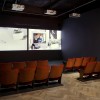Tate Modern’s latest exhibition, Paul Klee: Making Visible is a colossal retrospective of the modern master’s work, presenting 130 paintings and drawings over 17 gallery rooms.
The size of the exhibition, which nonetheless represents only a tiny fraction of the thousands of artworks completed by Klee during his 30-year career, bears testament to the astounding inventiveness and productivity of one of the 20th century’s most important artists.
An accomplished musician as well as an artist, Klee used pigments as a composer would use musical notes; abstractly evoking emotion, suggesting mood and even illuminating existential questions.
Compositions like Green X Above Left (1915), in which bright rectangles cover the painting’s surface except for one white square containing a green X demonstrate Klee’s idea of colour as atomic in the language of art. Klee sums up reality in it’s entirety in a patchwork of coloured shapes, with his blank void taking on a metaphysical nihilism.
Colour is also of essential important in Klee’s more figurative works. In Landscape with Flags (1915), Klee uses simplified shapes to suggest buildings, flags and the sky.
He then employs colour in a dream-like way, as if to bridge the gap between representing a real landscape and painting from imagination.
Although Klee is perhaps known primarily for his abstract, patchwork colour, this exhibition demonstrates how much creative variety accomplished throughout his career.
His paintings and drawings of human figures, such as Dispute (1929), Ghost of a Genius (1922), The Seafarer (1923) and Main Scene from the Ballet ‘The False Oath’ (1922), demonstrate wildly different styles: alternatively cubist, cartoonish, symbolic and grotesque.
Right up until his death, Klee seemed an artist obsessed with continuous aesthetic experimentation. Later paintings like Rich Harbour (1938) show a continued interest in creating complex images that border both realms of of figuration and abstraction.
A single visit to this exhibition could never be enough to do justice to such a varied and intriguing body of work.
As well as considering each individual, small-scale artwork deserving of close study, the chronological organisation of the show successfully gives an insight into Klee’s working processes and demonstrates the refinement and elaboration of his unique ideas and techniques over time.









